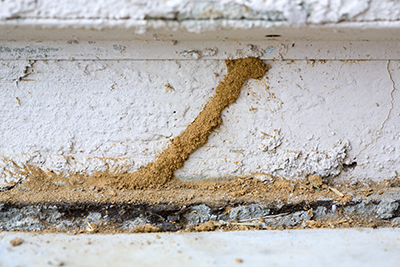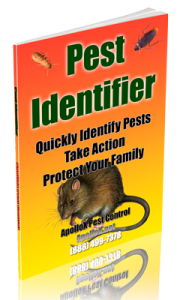Termite Prevention Basics – About the Subterranean Termite
 The subterranean termite is the most common termite infesting homes and businesses in the Northeastern U.S., so we’re focusing on subterranean termite prevention in this article. Termites cause nearly 3 times as much damage to wooden structures and crops as fires in the U.S. Put more exactly, fires account for about $11 billion annually in structural damage. Termites account for about $30 billion! So, “Termite Prevention Basics” begins with how to prevent the subterranean termite.
The subterranean termite is the most common termite infesting homes and businesses in the Northeastern U.S., so we’re focusing on subterranean termite prevention in this article. Termites cause nearly 3 times as much damage to wooden structures and crops as fires in the U.S. Put more exactly, fires account for about $11 billion annually in structural damage. Termites account for about $30 billion! So, “Termite Prevention Basics” begins with how to prevent the subterranean termite.
Subterranean termites, as the name indicates, live under ground and do not like to be exposed to the light. They’ve developed an ingenious method of staying underground, yet managing to get into the structure of a home. To do this, subterranean termites create a mud tunnel connecting their underground habitat with the structure they want to enter. In this way, they can literally enter a wooden structure without leaving their natural earthen habitat.
And here is the basic clue to preventing subterranean termites: Keep things dry. No moisture = no mud = no tunnel = no slick freeway entrance into the structure of your home or business = no expensive termite damage.
You see, whereas carpenter ants eat the kind of food we humans eat, and only create galleries for living in the wooden structure of a home, termites eat wood. Carpenter ants will usually leave the wooden structure fairly intact, minus their smooth galleries. Termites will turn the wooden structure into a crumbling mess, and, if untreated, actually bring the entire house down!
Termite Prevention Basics – Avoid the Moisture That Attracts Termites
 Consider and systematically eliminate the many ways that moisture can get into or under your home. Here are a few examples, but be creative and thorough as you consider your own home. We’ll start from the roof and work our way down:
Consider and systematically eliminate the many ways that moisture can get into or under your home. Here are a few examples, but be creative and thorough as you consider your own home. We’ll start from the roof and work our way down:
- Leaky roof, missing shingles, poor moisture barrier under the shingles.
- Leaky gutters sending rain run-off down your homes siding and into the wooden framework.
- Leaky plumbing. Inspect all pipes regularly. Do you have a boiler? Inspect that system also. Drippy faucets, running toilet, drain pipes – include these.
- Trees and shrubs rubbing up against the side of your house, or overhanging your home, dripping…water!
- Mulch touching the siding of your home. The mulch gets soaking wet during the rain. Guess what happens to the siding? The termites may not even need much of a mud tunnel to enter into your home.
- Poor drainage: Does the ground around your house slope towards your house? Reverse the slope. Sounds like a big project, but not as big as replacing your home!
- Check the garden hose connection for leakage.
- Next time it rains, watch where the rain water flows. Make sure it flows away from your home.
Termite Prevention Basics – Seal Any Openings
 In their winged reproductive phase, termites mate, fly to a location where there is moist, welcoming wood (they can sense the presence of moist wood–probably smells like your favorite meal). Then they enter the building, quickly drop their wings, and burrow into the moist wood to lay eggs and create a new colony of wood eating termites.
In their winged reproductive phase, termites mate, fly to a location where there is moist, welcoming wood (they can sense the presence of moist wood–probably smells like your favorite meal). Then they enter the building, quickly drop their wings, and burrow into the moist wood to lay eggs and create a new colony of wood eating termites.
Where are openings likely to be found? Again, let’s start from the roof and work our way down:
- Missing shingles.
- Openings in your homes siding, from warped or broken siding.
- Poorly caulked window and door frames.
- Cracked foundation.
- Again, be creative. If there’s an opening or crack, no matter how small, it’s a great entrance for a winged termite.
Note: If your home is completely sealed and you notice termite wings on your windowsill or around your home, it may be an inside job! The colony may already be present in your home.
Termite Prevention Basics – Now, Inspect Your Property
 Don’t stop with your home. Inspect your property, and any adjacent wooded areas. Here’s what to look for:
Don’t stop with your home. Inspect your property, and any adjacent wooded areas. Here’s what to look for:
- Wood piles: Keep them 20 feet from your home and garage, and out of direct contact with the ground. Create a moisture barrier or raise them up on some kind of water-proof support. This includes both firewood and lumber.
- Do your neighbors have termites? If so, it’s only a matter of time before they find their way into your home.
- Dead rotting trees, tree stumps, roots. These create perfect conditions for a termite colony which can then send winged emissaries into your home to create colony #2 or more.
Note that in nature, termites are doing a great service by breaking down dead wood so that it can re-fertilize the soil. You just don’t want them doing this with your home…which they will if they get a chance!
Termite Prevention Basics – Regularly Inspect Your Home or Business for Termites
No preventative measures are completely fail-safe. It’s best to inspect your home and property at least annually for the presence of termites. Look for their mud tubes, for crumbling wood and for termite wings. We suggest hiring a professional termite control expert like ApolloX Pest Control. A professional is trained and experienced to recognize signs of termite infestation that you might miss. And, if the infestation is there hidden away, and you leave it unattended for any period of time, there could be big damage – much more expensive than the cost of a professional termite inspection.
Call ApolloX Pest Control Now
(888) 499-7378
Termite Prevention Basics – What If It’s Too Late?
So, you suspect or discover the presence of termites in your home. Now what?
First you need to exterminate the termites. Completely locate every part of your home that could possibly be infested. How can you be sure you’ve found ALL the termite locations in your home? Best to hire a professional. It’s not worth “guessing” or “hoping”. You probably wouldn’t do that with a fire hazard. Remember that termites are 3 times as destructive as fire.
Call ApolloX Pest Control Now
(888) 499-7378
Second, you could use a termiticide. However, there’s a safety issue for humans and pets here, which is the reason that many jurisdictions require a licensed professional to apply a termiticide. Again, contact ApolloX Pest Control.
You could try a non-toxic remedy. There are many articles on the internet suggesting such remedies. However, do you really want to risk your home to a solution you found on the internet written by someone who has no accountability to you – a solution that MAY not work? The stakes are pretty high.
Call ApolloX Pest Control Now
(888) 499-7378
Experience peace of mind knowing that the problem has been eliminated.
Save a huge expense in repair costs.
In fact, be assured that you know exactly what needs to be repaired. We’ll let you know where the the termite damage is located in your home and what needs to be repaired.
We’ll even suggest a future termite prevention strategy based on your particular building and location.
Call ApolloX Pest Control Now
(888) 499-7378
View our mini-site HowToGetRidofTermitesCT.com












Recent Comments